
Problem #5
UCI. MAE200B, winter 2006. by nasser Abbasi.
Problem: Solve the following problems by transform methods
(a)

Consider the special case when
 .
Sketch the corresponding
.
Sketch the corresponding
 for various values of
for various values of
 .
.
Solution for part (a)
Some definitions first. The Fourier transform is defined as (using textbook definition)

and the inverse Fourier transform is

And the convolution is defined as

The shift property:
If
 has Fourier transform
has Fourier transform
 then
then
 has the Fourier transform
has the Fourier transform

The delay property:
If
 has fourier transform
has fourier transform
 then
then
 has fourier transform
has fourier transform

If
 has fourier transform
has fourier transform
 then
then
 has fourier transform
has fourier transform

and

And the property of differentiation

Now start the solution by assuming that

Start by taking the fourier transform of each term in the PDE w.r.t
 ,
and assume that
,
and assume that

and assume that the fourier transform of
 is
is

Hence

and

and

Now take the fourier transform of the PDE and using the above relations

Hence this is now a first order ODE, the solution is
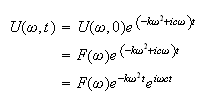
To find the solution
 then take the inverse fourier transform of the above
then take the inverse fourier transform of the above

Using the delay property we get

Hence the solution is

When
 ,
,
 hence
hence
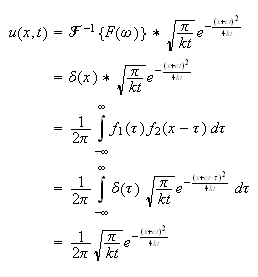
Hence the solution is

The effect of the term
 is
to introduce the term
is
to introduce the term
 in the exponential as shown above.
in the exponential as shown above.
 has units of distance, so the term
has units of distance, so the term
 acts as a shift in distance. So it is a transport phenomena. I.e. diffusion
with mass transport.
acts as a shift in distance. So it is a transport phenomena. I.e. diffusion
with mass transport.
This is a plot of the solution, I picked
 where the dirac delta function is to show how
where the dirac delta function is to show how
 changes with time at that location.
changes with time at that location.
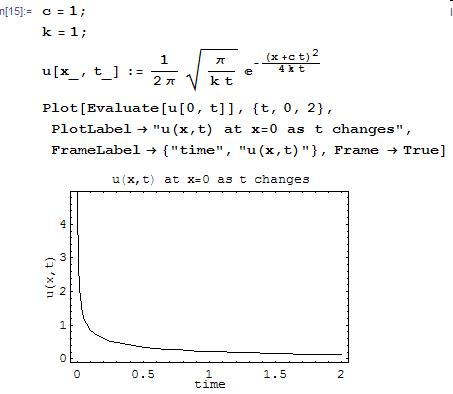
Problem: Solve the following problems by transform methods
(b)

Solution for part (b)
Start by taking the fourier transform of each term in the PDE w.r.t
 ,
and assume that
,
and assume that

and assume that the fourier transform of
 is
is

Hence

and

Now take the fourier transform of the PDE w.r.t
 and using the above relations
and using the above relations

Hence this is now a first order ODE, nonhomogeneous. Star by solving the homogeneous ODE. The solution is

To find the solution
 then take the inverse fourier transform of the above
then take the inverse fourier transform of the above
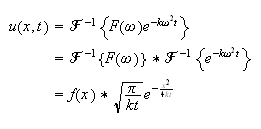
I am not sure if we should assume that
 as well as part(a) as the problem was not clear. To precessed, I assume so,
else not knowing what
as well as part(a) as the problem was not clear. To precessed, I assume so,
else not knowing what
 is one can not do anything more here.
is one can not do anything more here.
When
 ,
,
 hence
hence
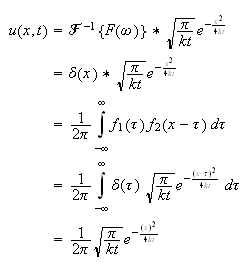
Hence the homogeneous solution is

Not knowing what
 is, assume that the particular solution is
is, assume that the particular solution is
 which can be found by using method of finding integrating factors, hence the
solution is
which can be found by using method of finding integrating factors, hence the
solution is

Problem: Solve the following problems by transform methods
(c)
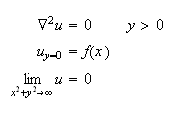
Solution for part (c)

Take fourier transform w.r.t
 ,
assume that
,
assume that

Take fourier transform of the PDE we obtain

This is a second order ODE, the characteristic equation is

solution is

Using the second B.C. that
 ,
this implies that
,
this implies that
 must be zero, else
must be zero, else
 will not vanish as
will not vanish as
 goes to
goes to
 .
Hence we obtain
.
Hence we obtain

Hence

But

Hence (1) becomes

at
 ,
,
 hence
hence

Hence

So the solution is

Problem: Solve the following problems by transform methods
(d)
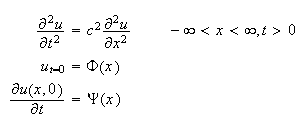
Solution for part (d)
Taking Fourier transform w.r.t

assume that

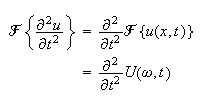

Hence the PDE becomes
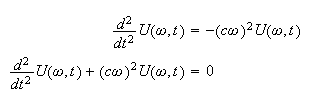
This is a second order ODE. The characteristic equation is

Hence

Hence the solution is

Apply BC, at


Apply second BC

at
 ,
, hence
hence

Hence we have 2 equations

Solve for A,B

Hence
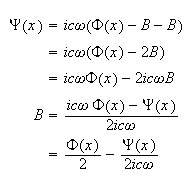
and
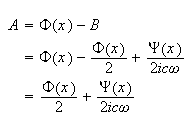
Hence solution is

Hence
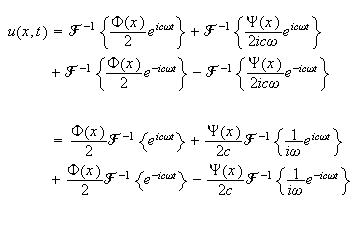
But

and

Where
 is the sign function which gives -1, 0 or 1 depending on whether
is the sign function which gives -1, 0 or 1 depending on whether
 is negative, zero, or positive
is negative, zero, or positive
and

and

Hence